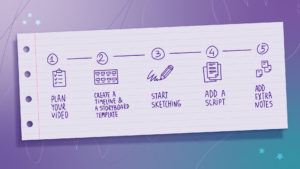


Author: Bob Jul 18, 2022 6 min read
One of the essential phases of the video production process is a storyboard. A detailed graphic representation is as vital for your video as a concise script. Once you have written a script, it’s time to draw a storyboard — a sequence of sketches that illustrate all the scenes of your future video.
It will enable you to organize your ideas into a visual representation, identify and fix any possible issues, and plan the video more effectively. In this article, we will define a storyboard, explain why it’s so important and provide you with some tips on creating one.
A storyboard is a collection of frame-by-frame illustrations describing everything that will happen in your video. This sequence of images will help your production team ensure the video is engaging enough and doesn’t have any inconsistencies. Besides sketches or photographs, storyboards are also equipped with text notes to clarify the visuals.

Experts can draw a video outline by hand or use storyboarding software like Plot, Studiobinder, or PanelForge. If you are not an artist, you can also use these tools to create simple images, applying various brushes and shapes. The finished piece looks like a comic book that elaborates the narrative’s sequence.
There are also several types of storyboards:
Using this method, artists create hand-drawn sketches and add text notes to visualize the video’s initial idea and describe what will happen on screen. You can use either simple illustrations or complex, detailed drawings. Traditional storyboarding allows specialists to make changes quickly and cost-effectively.
Although sketches are illustrative and easy to edit, they can’t show you the exact graphics and sound effects you intend to add to your video. These digital storyboards ensure fewer edits and rearrangements during the production process. Animated storyboards also enable you to manage the overall visual flow of your content more efficiently.
If you already understand how your future video will look once it’s delivered, thumbnail storyboards are a perfect match for your needs. This storyboarding type includes creating quick drawings on small pieces of paper. Such images don’t need to be detailed, making thumbnail storyboards more time-efficient.
A storyboard will help you organize your thoughts and preview what your video will look like once it’s ready. It’s also essential to show your production team, stakeholders and investors a visual representation of your content to convey your idea and vision.
Here are a few more reasons to create a storyboard:
It’s challenging to create a good video on the fly, as this process requires covering lots of tasks to get an engaging and memorable story. An informative road map enables you to manage various little details, plan the video better and visualize all the shots you need.
A storyboard allows you to reveal and resolve any possible problems before the production process starts. While writing a script, you may have missed some weaknesses that will be expensive to change during production or post-production. Storyboarding may inspire you to equip your video with additional sound effects or add new dialogues.
If you require a compelling marketing video, but your budget is limited, you require a storyboard. You won’t have to spend your time and cash filming useless shots, using unnecessary special effects, and paying for equipment rentals.
A storyboard will ensure transparent communication between you and your team. You will show your specialists what you have in mind, and it will be easier for them to give you descriptive feedback as the production process moves forward.
A storyboard is a collection of images showcasing each frame of your video. Whether you want your team to draw this road map on paper or use advanced software, you have to understand the core details of this project’s phase.
Take a look at five simple tips you need to make a storyboard and get ready for production:

Storyboarding is not just about creativity and drawing. Remember that your video should align with your business objectives and deliver value to your brand.
Do you want your content to bring more leads, demonstrate how to use your new product, or boost your company’s online visibility? Look through your script and make sure you defined the video’s objective, message, length, and marketing channels to publish and spread your content.
Divide your script into actions and identify your video’s beginning, middle part, and ending. Then, draw a series of squares on paper and leave some space for text notes under each panel. The number of your video’s actions should align with the number of squares you drew. In each panel, a specific scene of your video will take place.
Envision your script by drawing everything that happens in the video in your storyboard panels. You can draw by hand, use storyboarding software, or even cut relevant photos from magazines. Think of it as a draft that illustrates your video shots, so you don’t have to make your drawings look perfect.
Now, it’s time to number your frames and give some details about what is going on in every image. Beneath each panel, write down the line of your script, any spoken dialogues or narration that correspond to a particular drawing.
Look through your storyboard and add some extra notes to make your outline easy to understand. Consider including your requirements about voiceover, composition, props, sound effects, and the type of shot.
A storyboard will help you keep ideas organized, visualize your future video, and make sure everyone in your team is on the same page. Our WOW team is ready to create videos of any complexity to skyrocket your business. Contact us to make your ideas real!